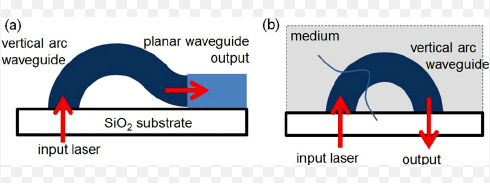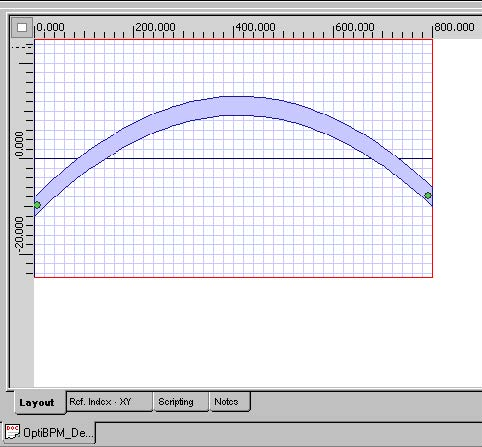Table of Contents
High Power Transmission
When a waveguide is used for transmission of power, the efficiency of its design is an essential factor defining whether the electric fields created are within the material’s breakdown strength. Thus, high levels of power transmission through waveguides are liable to arcing, which is a hazardous and disrupting phenomenon. In other words, arcing happens when the electric field inside the waveguide crosses the material-ionization threshold for the surrounding medium . The hazard of this scenario occurring is particularly high in the real-life example of microwave transmission through waveguides over large distances in the system of satellites for communication. If the power level exceeds the threshold of the waveguide, it can collapse at 40 kilowatts and above, which is an exceedingly hazardous outcome for satellite communication due to the high repair costs and required high level of technology and engineering skills.
To implement a solution for the problem, one can select a new waveguide with larger cross-sectional dimensions. Because the larger area facilitates a more disperse electric field, the intensity is bound to be low, around 30 kilowatts. That is, the dimension of the new, thicker waveguide has been selected to be around 20% higher than the maximum level of power that can be put through. A common example of the significance of adjusting the waveguide thickness to reaching optimal safety from arcing is radar. In the example of radar systems used in air traffic control, if arcing occurs, the system will not be precise and run the risk of falling apart, as the sensitive system elements are prone to break under the arcing electric field. Therefore, in air traffic control, the waveguides’ power intensity is monitored constantly, ensuring that dysfunctional shifts are promptly addressed. Changes in the dimension of a waveguide implemented for this purpose, as described, help control the power transmission, avoid arcing, and optimize long-term spending on devices due to the minimization of wasted energy on ionization of atmosphere around the waveguide and the costs of downtime that can be as high as tens of thousands of dollars per year.

Material Breakdown
The choice of material drastically affects the tendency of waveguides to arcing because it depends on the material’s capacity to withstand high electric fields. On the smaller side of the scale, one of the more common material choices for waveguide creation is aluminum. It has a reduced breakdown strength of approximately 30 kV/cm, which is sufficient for lower applications of power . In the case of high power, as seen in high-energy physics experiments, much more conductive materials such as copper or silver, which also have higher break strengths, are needed. Copper waveguides, for instance, can properly manage electric fields up to 40 kV/cm before arcing is a concern. These materials are highly efficient, minimizing energy loss and improving peak effectiveness even in extreme situations.
Connection to Practical Material Problems
Waveguides are commonly employed in telecommunications to direct radio frequency energy. The most appropriate material choice both prevents arcing and contributes to the general durability and longevity of the system. In an urban area where high power is necessary and material wear and tear can greatly affect the system’s integrity, the selection of copper could result in a 15% savings with regards to operational costs. These potential costs stem from a variety of sources, such as the cost and frequency of maintenance caused by downtime, repairs, or reduced efficiency. The treatment of aluminum via anodizing is particularly crucial in highly volatile power and environmentally stressful applications. This treatment allows for increased surface hardness, thereby enhancing the breakdown threshold and the overall service life of an anodized waveguide system. In an area such as aerospace and defense where system failure may result in catastrophic consequences, having a process in place that attempts to improve the longevity and dependability of waveguide technology has the potential to be highly advantageous.
Impurities and Contaminants
The internal presence of impurities and contaminants significantly influences the arcing threshold of a waveguide condition . Dust or metal filings act as focal points for discharges, as opposed to surfaces completely without. The electric field in a waveguide is no longer maintained uniformly, and high-intensity regions with a surface intensity sufficient to cause breakdown or arcing can exist in the waveguide. In addition, waveguide environments must remain ultra-clean in various industrial applications. For instance, the microwave is employed in the manufacture of semiconductors, and a waveguide on the production line becomes so contaminated that it is arcing.
Repairing damaged machinery would cost extra, but even shutting it down for an hour costs $5,000 in productivity. As a result, waveguides are subjected to cleanliness inspections and cleaning at between 2000 hours and 6000 hours to them no longer conduct electricity. Increased cleanliness results in up to 70% fewer arcing events. Cleanliness practices to reduce energy consumption tend to become more stringent, with the use of Tahitian cleaners, ultra-smooth surfaces, ultrafine burrs, clean flanges, and O-rings cleaned in clean-room environments . I agree with the fact that waveguide cleanliness affects the arcing threshold. The reduced mechanical and energy efficiency from arcing is influenced by the relatively maintenance and determining factors into a wondrous world aid . Lowering the arcing rate on telecommunications equipment increases the life of the infrastructure, which means that the customer will receive a higher return on effective performance through value. The costs associated with cleaning procedures are insignificant compared with the increased energy savings and repairs.
Mismatched Impedances
Waveguide Systems
In waveguide systems, a mismatch of impedances between components can cause reflections and, possibly, standing waves. This can increase the risk of arcing. Typically, the problem is that the components experience a mismatch of their impedance values, and power is not transferred effectively, resulting in a localized electric field strength spike. A practical example is in broadcasting systems that require high signal quality. Here, if the transmitter and the waveguide are mismatched in their impedance values, the result will be various reflection points along the waveguide. Not only does this degrade the quality of the broadcast, but it also increases the risk of arcing. Consequently, the transmitter, particularly, and other components will be at risk of damage. To solve this see frequency matching products—device or adapter applications, the reflection in the system will be reduced from 20% to 1% or less, minimizing arcing risk.
Cost Efficiency and Longevity
Employing these impedance matching solutions not only retains the quality of transmission but also can lengthen the entire systems’ service lifetimes. If there is an impedance mismatch, the final maintenance cost at a television broadcasting station [typical for the U.S., Europe, or another developed region] would be an estimated $10,000 annually. At the same time, the cost of equipment, lost labor hours, and any other downtime and repairs would sum to more than $1,000 to fix the problem. However, with adaptation in place, the cost would only be the one-time cost of the matching device, or the design cost of the system.

Mechanical Deformations
Deformation of various magnitudes of the mechanical type in waveguides , such as bends or vertical, horizontal and sideway dents, can cause significant changes in the distribution of the electromagnetic fields that these accommodation paths of microwave signals support. In particular, they can lead to the increase in prevalence of spots with higher electric-field power, which in turn intensifies arcing. According to ASDreports , the effects of deformation might vary from the welded seams’ destruction or inefficient water removal in twisted units in beeline/pipeline runs to the broken branches’ deformation in buried ones .
Impact and Prevention in Practical Scenarios
Even the smallest cases of waveguide deformation can cause arcing and interrupt microwave signal delivery in high-speed transmission networks. For instance, in a fiber-optical communication system with a light beam as a signal carrier, even a relatively loose bend such as exceeding the manufacturer -specified radius by a few millimeters can result in the increase in signal loss by up to 0.5 dB per each bend. To avoid these issues, regular, ideally, automated, measurements should be performed throughout the installments using robotic inspection instrumentation. For example, Elecroimpact rotating displacement sensors are capable of detecting discrepancies up to 0.1 mm , so they can be supported by force-predicting software from ANSYS, Inc . to define the probability of arcing based on the existing deformation.
Economic Benefits and Enhanced Performance
The deformation of waveguides can be reduced by 80 – 90% through advanced manufacturing processes, such as installation of automatic equipment for alignment and stress testing. As a result, the lifetime of transmission systems becomes longer, as they are less prone to arcing and, therefore, fewer issues with signal delivery require immediate repairs and cause lasting damage. If the number of arcing cases is reduced, medium-sized telecommunications networks can save at least $15,000 per year on maintenance.
Temperature Effects
Temperature fluctuations have a considerable effect on the waveguide’s performance, especially on arcitiability. High temperatures decrease the dielectric strength fo the materials and air inside the waveguide, increasing the arrest pressure and causing arcing.
Application in Industry
In many industrial applications, waveguides are used to transport high levels of power such as in power plants or industrial lasers. Therefore, managing ambient and internal temperatures is very important. For example, in plasma cutting systems, the waveguides are frequently near their temperature limits and need to be able to resist arcing under the most extreme conditions. The risk fo arcing increases by up to 50% for temperature increases beyond 100 degrees Celsius. Eventually, arcing interrupts the cutting process, leading to inaccurate cuts, which may have to be recut, causing additional issues and wear to the cutting systems.
In such settings, cooling systems are essential, and either force air or liquid would be able to push temperatures back to control levels. Lowering the temperature by 30 degrees will double the dielectric strength of the air inside and decrease the arcing incidence by 60%.
Costs and Efficiency
Aside from the security concerns regarding arcing, these temperature control systems can get very efficiency at handling equipment. For telecommunications, where signal quality and quality is a major concern, controlling the temperature ensures that communication equipment will continue to operate as intended for a longer period. The one-off initial costs are outweighed by the benefits from causing fewer failures and reduced maintenance. The average telecommunications provider will see a yearly saving of around $20,000 for repair and replacement jobs.







